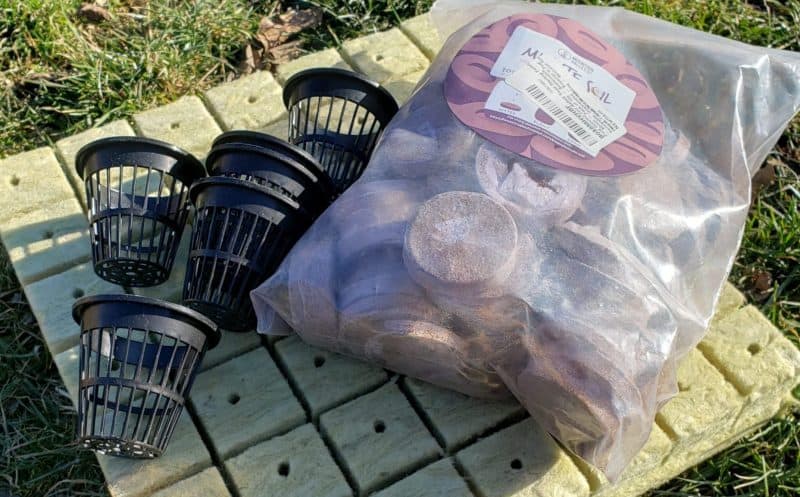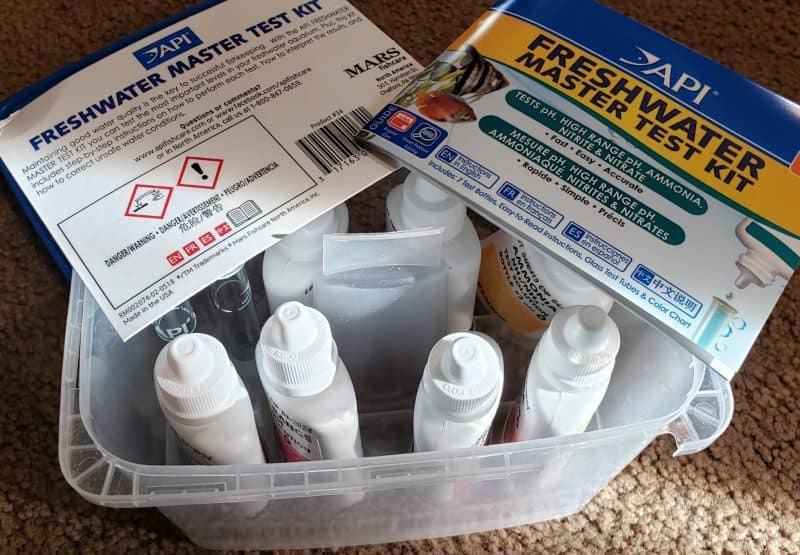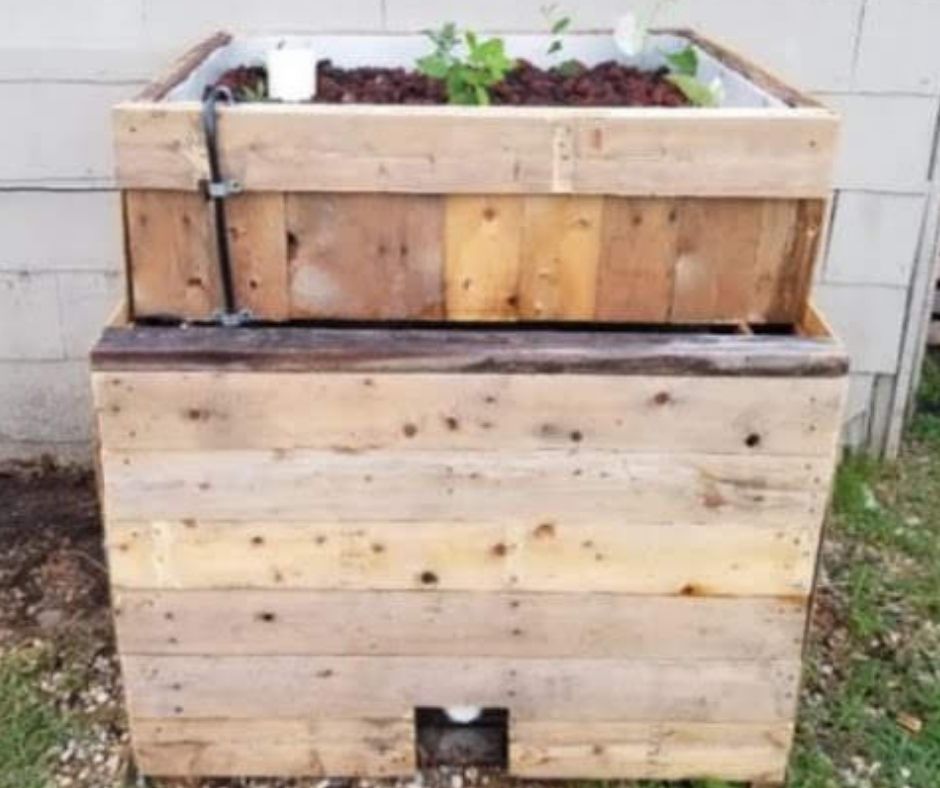When you can’t grow a garden outside for whatever reason, perhaps you have no land or it’s the dead of winter, you can still have fresh homegrown vegetables by setting up an indoor fish tank aquaponics system.

Aquaponics is a sustainable form of agriculture that combines raising fish and growing plants. The nutrient-rich water created by the fish supplies the plants with everything they need to grow and in return the plants and microorganisms created by the system clean the water for the fish. Aquaponic systems are very scalable and can be done on a large commercial scale or home scale depending on your needs.
A Few Of The Many Benefits Of An Indoor Aquaponics System
- Aquaponics can produce both fish and plants for food.
- The system can produce a natural fertilizer for plants.
- Growing food using aquaponics uses much less water than conventional gardening.
- Aquaponic systems are generally a much more productive way to garden.
- Makes gardening possible with no land when done indoors.
- Makes gardening possible in any climate and in any weather.
How This Indoor Fish Tank Aquaponics System Works
There are a few different designs to choose from when building an aquaponics system. Most large commercial systems are floating raft systems in Deep Water Culture (DWC) but I prefer a flood and drain (CHOP 2) system for a small-scale home system. CHOP stands for “Constant Height, One Pump” and the 2 means that the pump flow runs in two different directions, One flowing to the grow beds and the other flowing to the fish tank. Below is a simple diagram of how my system works.

Starting at the pump which is located at the bottom of the sump tank at the lowest point of the system, water is pumped up and goes in two directions through a PVC T-Connector.

Grow Bed Water Supply
The water flowing to the beds goes first to a manifold with three outlets which supplies the water to the 3 beds. When the water leaves the manifold it flows through a ball valve that can be adjusted to regulate the amount of flow to each bed. The reason you need the valves is because the water will naturally have more pressure into the lower beds than the highest bed, so by partially closing the valves to the lowest beds you can increase the volume going to the upper beds.

The water then flows through a bulkhead installed in the bottom of the grow beds increasing the water level until it overflows at the level set by the standing tube attached to another bulkhead installed in the bottom of the bed. The overflow then goes back to the sump tank completing the cycle of the water to the beds.
The pump on my system runs 4 minutes every hour which is just a few seconds longer than it takes to fill all the beds to the level I want it at set by the standing tube. When the pump shuts off the water below the standing tube back flushes through the supply system and back through the pump to return to the sump tank. This empties the beds completely of water until the next pump cycle.
Fish Tank Water Supply
The water flow going to the fish tank also flows for 4 minutes every hour when the pump turns on. It flows up from the pump to the PVC T-Connector and in the opposite direction of the bed supply. There is also a ball valve in this line as well to control the amount of water flow going to the fish tank. Partially closing this valve ensures enough pressure going to the beds and prevents too much volume from going to the tank which could overtake the fish tank overflow pipe and cause the tank to overfill.
When the water in the fish tank starts rising the water will begin to run through the overflow pipe which returns the water to the sump tank. Running the pump for 4 minutes every hour maintains clean water to the fish tank and sends the nutrient-rich water to the sump to be used by the plants.
Aquaponics System Parts List
These are the parts I used to build this particular setup however there are changes I would make in the shelving size if I were to do it over as mentioned in the accompanying video to this article. This change would inevitably lead to changes in some of the other parts of the system.
- 2 bags- GEOLITE Clay Pebbles from Amazon TIP: Wash these well before you put them in your grow beds!
- Barrina LED Grow Lights from Amazon
- 2 – Nearpow Multifunctional Infinite Cycle Programmable Plug-in Digital Timer Switch from Amazon
- 3- All Purpose Tubs 20″ W x 26″ L x 6″ D from Menards (also available at Amazon for a higher price)
- 6- 1/2-Inch Double Threaded Bulkhead from Amazon (might be cheaper at your local hardware store)
- 30 – 55 Gallon Fish Tank (I recommend you purchase a used tank locally from Facebook Marketplace or Craigslist)
- 5 Shelf Plastic Freestanding Shelving Unit 36″ W x 72″ H x 18″ D from Menards
- Tetra 1,200 GPH X-Large Pond Pump from Menards
- Sump Totes
- 12′ – 1/2″ PVC Pipe
- 8′ – 3/4″ PVC Pipe
- 10 – 1/2″ PVC 90° Elbows (available in 10 pack on Amazon, check your local hardware store)
- 1 – 1/2″ PVC T-Connector (available in 10 pack on Amazon, check your local hardware store)
- 5 – 3/4″ PVC 90° Elbows (available in 10 pack on Amazon, check your local hardware store)
- 4 – 3/4 ” PVC T-Connectors (available in 10 pack on Amazon, check your local hardware store)
- 3 – 1/2″ PVC slip to thread adapter (available in 10 pack from Amazon, check your local hardware store)
- 2 – 3/4″ PVC End Caps (available in 10 pack from Amazon, check your local hardware store)
- 12 – Tube Fitting Adapters 1/2″ Barbed x NPT Male straight on Amazon
- 1 – 1/2″ PVC Threaded to Slip Adapter on Amazon (check your local hardware store for a better price)
- 4 – Tube Fitting Adapters 1/2″ Barbed x NPT Male 90° elbow (available on Amazon in a 10 pack, check your local hardware store)
- 4 – 1/2″ Threaded Ball Valves on Amazon
- Vinyl Tubing 20′ x 1/2″ on Amazon

Choosing The Right Fish For Your Aquaponics System
An indoor fish tank aquaponics system does limit you on the type of fish you may want to use compared to a larger outdoor or commercial system but there are some great options.
Goldfish
I know what you might be thinking, that’s not a fish you’re going to eat. You’re right, but if your main purpose is growing vegetables then goldfish are a great option. They produce a lot of waste and are inexpensive and easily available anywhere fish are sold. For me, it was a logical decision because the goldfish in my system are from my small backyard pond and I wanted to bring them in for the winter, so I thought why not build an aquaponics system to keep their water clean and also get some vegetables.

Bluegill or Perch
These panfish breeds make fantastic fish for an indoor aquaponics system with all the benefits. They don’t get so large they can’t be raised in an aquarium, they give off plenty of waste, and when they grow large enough you can enjoy a fillet of fish with the salad you made from your system.
Catfish
Catfish are excellent aquaponics fish but may or may not be ideal for your system. If you are going with a large enough tank or are only keeping them in a tank to a certain size and then transferring them to a larger outdoor system or backyard pond then they might work great. If you are planning on raising them to full size in your system it may not be a great idea as they can get very large.
Tilapia
Probably one of the most common fish used in aquaponics systems is tilapia. They grow fast and fairly large so they are not the best breeds for an indoor system like this. However, if like the catfish, you are only planning on keeping them there temporarily in their smaller growth stage they will work great.

Growing From Seed In An Aquaponics System
When it comes to seeds we may tend to think they need to be put into the soil to germinate. While soil does create the required environment for the seeds there are other ways to get seeds to sprout.
Many seeds can be put right into the grow media but this may not be the best way since the water level will constantly rise and lower and carry the seed with it to some degree until it roots. Generally, the seeds will germinate this way but it’s hard to control where they will eventually end up or how deep in the media they will land as they are moved around.
Coconut Coir
A great option for seed starting in a flood and drain aquaponics system is using Coconut Coir Netted Seed Starting Pellets. I like coconut coir over peat pellets for a couple of reasons. For one they are a better renewable resource option. Coco coir also provides more aeration than peat which is great for aquaponics.
Rockwool
Rockwool Starter Plugs are another great option for seed starting. Until I built this system I had never used rock wool starter plugs before so I planted about half of my seeds in coco coir pellets and the other half in rock wool as an experiment. To my surprise, the rock wool outperformed the coco coir slightly but this also came with a little extra expense so I feel like all things being equal they are both great options.

What You Can Grow In An Aquaponics System
The short answer is you can grow almost anything in an aquaponics system that will grow in soil. However, the size and design of your system will determine if it’s practical to grow some things or not.
In this particular design, low-growing leafy greens and smaller vegetables are ideal. You can also grow larger plants such as chard and kale and pick from them as the leaves are smaller. Many herbs would also do very well in a system this size.
In my system, I am currently growing Rainbow Chard, Romaine lettuce (although Black Seeded Simpson lettuce would be a better choice), Green Onions, Bok Choy, Celery, and Spinach which bolted too quickly.

Caring For Your Aquaponics System
There are 3 things you need to supply this system to keep it functioning efficiently. The proper amount of light, water that meets the needs of the system, and food for the fish.
Light
I mentioned in the parts list 2 items that take care of this need. The Barrina LED Grow Lights and the Nearpow Multifunctional Infinite Cycle Programmable Plug-in Digital Timer Switch. The grow lights come in a 6 pack of 2 ft. long lights which I mounted two side by side right above the grow beds on the bottom of the shelf above. I then plugged these lights into the timer switch which keeps the lights on for 14 hours a day.
Water
The first thing you need to do when it comes to water is to keep enough of it in the system. I generally have to add about 5 gallons a week to the sump tank to account for loss due to evaporation and uptake of the plants. If you let the sump tank go too low you could burn up your pump if it starts sucking air.
The second thing you need to know when it comes to water is how to make sure it’s balanced for your system. It is my opinion that many people who practice aquaponics worry about this too much and overcomplicate it. I have been doing aquaponics successfully for 4 years and have NEVER had to add anything to my system to keep it healthy and functioning properly. I’m not saying it could never happen, I’m just saying it probably isn’t as big an issue as many make it out to be.
That being said, it is a good practice to routinely check the levels in your system. The best test kit I’ve found for testing the water in my aquaponics systems is the API Aquarium Test Kit. There are a few things to consider when it comes to the proper water for your system, they are pH, Ammonia, Nitrite/Nitrate, Temperature, Oxygen, and Alkalinity. Don’t let all that scare you we are going to rule out a couple of issues right away.

Temperature
That’s is part of the beauty of an indoor aquaponics setup. Your water will always be at room temperature so this is never going to be an issue for you.
Oxygen
The way this system is designed to transfer water in and out of the tank for 4 minutes every hour ensures that the water will always be oxygenated and the fish will be energetic and hungry.
Alkalinity
Although pH and Alkalinity aren’t the same things, the alkalinity should be within the proper range if pH is within its proper range. So we will focus mainly on the proper pH balance.
Ammonia, Nitrite/Nitrate
Fish urine puts off ammonia and if the ammonia levels rise too high it can kill your fish and your plants so this is an important measurement. Usually, you will only have the problem of high ammonia in a young aquaponic system. When a system matures and contains the bacteria it needs to convert the ammonia to nitrite and then eventually to nitrate and then the plant root system and can take it up it, this should cease to be an issue.
The optimal ammonia level for fish is less than 0.25 ppm. If early on your system gets too high in ammonia you may have to do a water change in the fish tank. However, this is not likely with this system when everything is working as it should.
pH Balance
This is probably the most common issue with an aquaponics system. Fish and plants have a different ideal pH level so you need to maintain a balance in between their ideal ranges. You will want to keep your system’s pH level between 7.0 and 7.5 in order for it to function best for both your fish and plants.
Feeding The Fish
Growing a garden in an aquaponics system is great! No weeding, no watering, low maintenance, hardly any daily activity at all, except one very important daily activity. Don’t Forget To Feed Your Fish!
If you truly don”t have time to tend to the chore of feeding your fish every day you can add an automatic feed feeder to the system which will even further lower the daily responsibilities of the care of this system.
Building and using an indoor fish tank aquaponics system is a learning experience and no doubt you will have more questions as time goes by. So enjoy the journey and seek the answers as the questions come and if failures happen, don’t give up, it’s worth it!
If you’re interested in doing Aquaponics outdoors, check out my post on how I built a Chop and Flip IBC Tote Aquaponics System.




